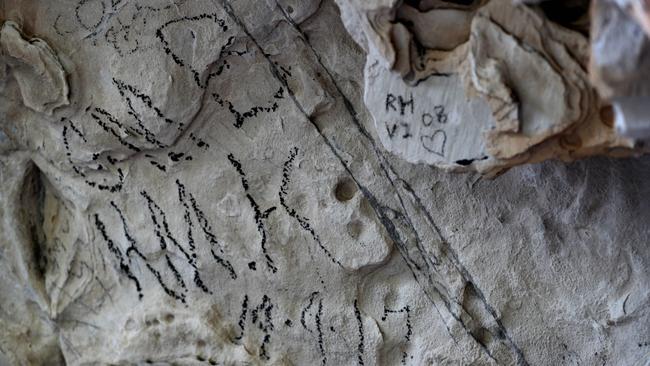Valuable Aboriginal rock art neglected despite warnings
A systemic failure of policy over many decades has compromised southeastern Australia’s most valuable Aboriginal rock art, leading to neglect and failure to combat desecration of sacred sites.

VIC News
Don't miss out on the headlines from VIC News. Followed categories will be added to My News.
A systemic failure of policy over many years has jeopardised southeastern Australia’s most valuable Aboriginal rock art, leading to a failure to fight the desecration of sacred sites.
Official documents show governments have known for decades that Grampians National Park indigenous art has been vulnerable due to a failure to properly protect heritage sites.
Archaeological, conservation and cultural heritage experts have warned for decades that erosion, vandalism, overuse and general neglect were occurring.
One report lamented the Grampians had become a human desert, where evidence of indigenous heritage was being erased.

A 1982 Victorian Archaeological Survey warned that erosion of rock paint was leading to art disappearing and that an “ultimate salvage’’ operation was needed to save it.
The reports came many years before Parks Victoria imposed a 500sq km ban on rock climbing in a move condemned by the international climbing community.
The Herald Sun can reveal a new report into rock art and climbing in the Grampians will detail how Parks Victoria failed to communicate for decades to climbers about cultural heritage issues in the park.
That report, prepared by cultural heritage expert Ben Gunn, Parks Victoria’s Jake Goodes and others, is critical of rock climbing in parts of the park, particularly the use of bolts and chalk, accusing some climbers of vandalism.

It notes that discussions were held with climbers as far back as the 1980s about rock art but it appears Parks Victoria did not act on the concerns until the start of this year, when it imposed the bans without an education process or meaningful discussions.
Australian Climbing Association Victoria president Mike Tomkins said there was no evidence that climbers had vandalised sacred sites.
A Parks Victoria spokesman said: “The damage that has occurred to heritage sites in the Grampians is unacceptable and we are currently working with traditional owners, local communities and key user groups to raise awareness of, evaluate and remediate sites of significance.’’
In 2001, Professor Ian Clark warned that governments had failed to properly manage 10 key indigenous art sites.
MORE NEWS:
CHILD BRIDE IMAM’S BID TO WORK WITH KIDS
BIN NIGHT SET TO GET BECOME MORE CONFUSING
Citing a 1990 meeting at Halls Gap, he said there had been confusion about managing the issue.
“The condition of the public art sites had degenerated to such a state that they were an embarrassment,’’ he said.
The first reports of vandalism at the Grampians were as early as the late 1800s.
The government has been trying to resolve the climbing row, with suggestions a compromise will be reached after voting occurs in the Victorian treaty process.
